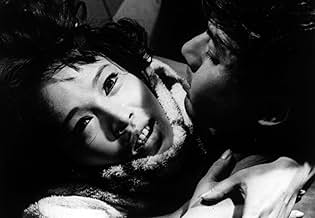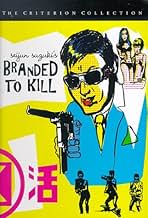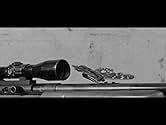IMDb-BEWERTUNG
7,2/10
10.584
IHRE BEWERTUNG
Füge eine Handlung in deiner Sprache hinzuAfter a botched assignment, a rice-fetishizing hitman finds himself in conflict with his organization, and one mysterious, dangerous fellow-hitman in particular.After a botched assignment, a rice-fetishizing hitman finds himself in conflict with his organization, and one mysterious, dangerous fellow-hitman in particular.After a botched assignment, a rice-fetishizing hitman finds himself in conflict with his organization, and one mysterious, dangerous fellow-hitman in particular.
- Auszeichnungen
- 1 wins total
Jô Shishido
- Gorô Hanada
- (as Joe Shishido)
Annu Mari
- Misako Nakajô
- (as Anne Mari)
Akira Hisamatsu
- Ophthalmologist
- (as Kôsuke Hisamatsu)
Kôji Seyama
- Restaurant Guest
- (as Takashi Seyama)
Handlung
WUSSTEST DU SCHON:
- WissenswertesWhen Nikkatsu studio executives saw the finished product, they thought it was too terrible to be released, so they shelved it. Seijun Suzuki along with others in the film business, film critics, and students protested in unfairness since, by contract, Nikkatsu was supposed to release the finished film theatrically. It went to court, with a ruling in favor of the director. Nikkatsu had to pay for damages and have the film released. Suzuki's contract with Nikkatsu was terminated, and with the bad reputation, was unable to work on a feature film for the next 10 years.
- VerbindungenFeatured in Seijun Suzuki | TCM (2013)
- SoundtracksKoroshi no buruusu (Killing Blues)
Lyrics by Hachiro Guryu (Yasuaki Hangai, Takeo Kimura, Okada Yutaka, Chûsei Sone, Seijun Suzuki, Yôzô Tanaka, Seiichiro Yamaguchi and Atsushi Yamatoya)
Music by Kagehisa Kusui
Sung by Atsushi Yamatoya
Ausgewählte Rezension
Seijun Suzuki made 42 films for Nikkatsu Studio, 1967's "Branded to Kill" being his last. It was his last because he was fired (while still under contract) for making a film that made no sense and no money. Suzuki sued the studio for breach of contract and as a result was blacklisted by the Japanese film industry. Undeterred, he worked in television for ten years before returning to the big screen in 1977. But time loves an artist and his art and in recent years "Branded to Kill" has been championed by film makers, film students and critics and is now considered a classic.
Hanada is a yakuza hit man with ambition. He is the No. 3 ranked assassin and wants to be No.1. But things aren't going right. He botches an assignment to provide protection for a boss then blows a hit when a butterfly lands on his rifle sight as he is ready to pull the trigger. The mob then puts out a hit on Hanada and he is on the run. But he has more problems than that. His sexy wife (who has more gratuitous nude scenes that I thought possible in a Japanese film of this era) is sleeping with Hanada's boss and Hanada is stalked by the mysterious No.1.
A straightforward plot is completely lost in a totally confusing narrative that has events out of chronological order, changes in space and time, and shifts in tempo that leave the viewer thinking that they are either watching the worst edited film of all time or they have somehow slipped into a David Lynch parallel universe. Suzuki's film grammar is that there is no grammar. You can do anything you want as long as it keeps the film interesting – and entertaining. The result is a fascinating, bizarre and mystifying film that is not only highly original but dazzling to look at. The black and white Cinemascope looks as good as anything I've ever seen and the camera direction is inspired.
But the look of the film is not disconnected from the story. The expressionist style – amazing lighting effects, surreal widescreen images and the confusing edits – all create a nightmare film language that mirrors the nightmare that Hananda is experiencing within the story. There is a femme fatale who has a dead bird hanging from her cars rear view mirror (which, actually, would be better than one of those ghastly air fresheners), lives in an apartment full of dead butterflies strung up into a lacy embroidery and has an attraction for water that leaves her glistening wet in most scenes. BTK also has an absurdist comic feel to it: James Bond loves his vodka martini's, Hanada loves his boiled rice. And in a scene that has since been copied, Hanada shoots someone by firing a bullet into a basement drainpipe, the bullet traveling up through the pipe and out of a sink on the second floor and into the eye of an optometrist. It all seems to work as it plays with the usual yakuza themes: loyalty and honor, an existential loner hit man, double crosses and hit men assassinating other hit men.
This film is not for those who prefer a straightforward narrative or a film with a logic that can be discerned by simply watching it again. But others will find this fascinating film something they will want to watch again...and again.
Hanada is a yakuza hit man with ambition. He is the No. 3 ranked assassin and wants to be No.1. But things aren't going right. He botches an assignment to provide protection for a boss then blows a hit when a butterfly lands on his rifle sight as he is ready to pull the trigger. The mob then puts out a hit on Hanada and he is on the run. But he has more problems than that. His sexy wife (who has more gratuitous nude scenes that I thought possible in a Japanese film of this era) is sleeping with Hanada's boss and Hanada is stalked by the mysterious No.1.
A straightforward plot is completely lost in a totally confusing narrative that has events out of chronological order, changes in space and time, and shifts in tempo that leave the viewer thinking that they are either watching the worst edited film of all time or they have somehow slipped into a David Lynch parallel universe. Suzuki's film grammar is that there is no grammar. You can do anything you want as long as it keeps the film interesting – and entertaining. The result is a fascinating, bizarre and mystifying film that is not only highly original but dazzling to look at. The black and white Cinemascope looks as good as anything I've ever seen and the camera direction is inspired.
But the look of the film is not disconnected from the story. The expressionist style – amazing lighting effects, surreal widescreen images and the confusing edits – all create a nightmare film language that mirrors the nightmare that Hananda is experiencing within the story. There is a femme fatale who has a dead bird hanging from her cars rear view mirror (which, actually, would be better than one of those ghastly air fresheners), lives in an apartment full of dead butterflies strung up into a lacy embroidery and has an attraction for water that leaves her glistening wet in most scenes. BTK also has an absurdist comic feel to it: James Bond loves his vodka martini's, Hanada loves his boiled rice. And in a scene that has since been copied, Hanada shoots someone by firing a bullet into a basement drainpipe, the bullet traveling up through the pipe and out of a sink on the second floor and into the eye of an optometrist. It all seems to work as it plays with the usual yakuza themes: loyalty and honor, an existential loner hit man, double crosses and hit men assassinating other hit men.
This film is not for those who prefer a straightforward narrative or a film with a logic that can be discerned by simply watching it again. But others will find this fascinating film something they will want to watch again...and again.
Top-Auswahl
Melde dich zum Bewerten an und greife auf die Watchlist für personalisierte Empfehlungen zu.
- How long is Branded to Kill?Powered by Alexa
Details
- Laufzeit1 Stunde 31 Minuten
- Farbe
- Seitenverhältnis
- 2.35 : 1
Zu dieser Seite beitragen
Bearbeitung vorschlagen oder fehlenden Inhalt hinzufügen

























